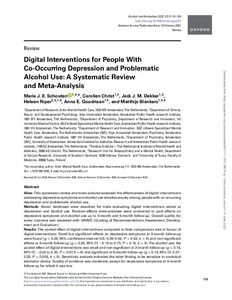Digital Interventions for People With Co-Occurring Depression and Problematic Alcohol Use: A Systematic Review and Meta-Analysis
Schouten Maria JE; Blankers Matthijs; Goudriaan Anna E; Christ Carolien; Dekker Jack JM; Riper Heleen
https://urn.fi/URN:NBN:fi-fe2022081154150
Tiivistelmä
Aims: This systematic review and meta-analysis assessed the effectiveness of digital interventions addressing depressive symptoms and alcohol use simultaneously among people with co-occurring depression and problematic alcohol use.
Methods: Seven databases were searched for trials evaluating digital interventions aimed at depression and alcohol use. Random-effects meta-analyses were conducted to pool effects on depressive symptoms and alcohol use up to 3-month and 6-month follow-up. Overall quality for every outcome was assessed with GRADE (Grading of Recommendations Assessment, Development and Evaluation).
Results: The pooled effect of digital interventions compared to their comparators was in favour of digital interventions. Small but significant effects on depressive symptoms at 3-month follow-up were found (g = 0.34, 95% confidence interval (CI): 0.06-0.62, P = 0.02, k = 6) and non-significant effects at 6-month follow-up (g = 0.29, 95% CI: -0.16 to 0.73, P = 0.15, k = 5). For alcohol use, the pooled effect of digital interventions was small and non-significant at 3-month follow-up (g = 0.14, 95% CI: -0.02 to 0.30, P = 0.07, k = 6) and significant at 6-month follow-up (g = 0.14, 95% CI: 0.07-0.20, P = 0.005, k = 5). Sensitivity analysis indicated the latter finding to be sensitive to statistical estimator choice. Quality of evidence was moderate, except for depressive symptoms at 6-month follow-up for which it was low.
Conclusion: Based on the literature, digital interventions are effective in reducing depressive symptoms at 3-month follow-up and alcohol use at 6-month follow-up among people with comorbid depression and problematic alcohol use. More high-quality trials are needed to confirm the current findings.
Kokoelmat
- Rinnakkaistallenteet [19218]
